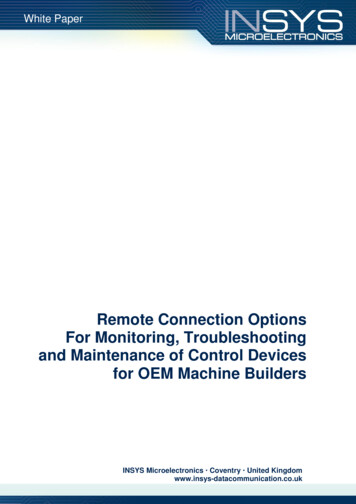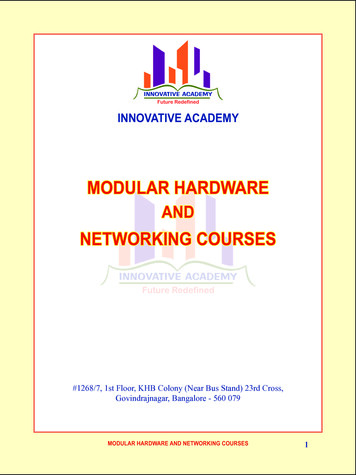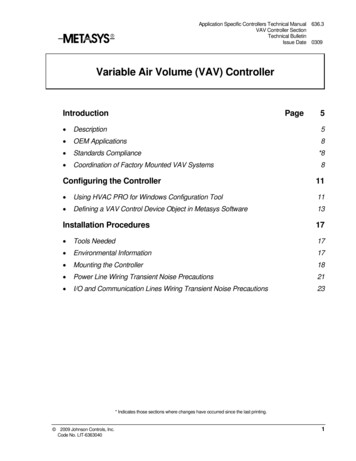
Transcription
White PaperRemote Connection OptionsFor Monitoring, Troubleshootingand Maintenance of Control Devicesfor OEM Machine BuildersINSYS Microelectronics Coventry United Kingdomwww.insys-datacommunication.co.uk
Introduction:Each year an OEM machine-builder can spend thousands of pounds on expensive on-site interventioncosts (including related travel expenses) in many cases to arrive on site and find that a simple fix orparameter adjustment is all that was required. This whitepaper discusses the options available to OEMmachine builders to avoid unnecessary costs by using a remote connection to the electrical controlequipment. This means that typical operations such as equipment maintenance programs, configurationchanges or PLC programming can be handled directly from the OEM business premises or other remotelocations.This paper deals with the physical connection methods and assumes that any locally approved UserAccess and Authentication Policies and IT Procedures are followed. Also any remote control of plantand machinery should be fully assessed and understood and follow the appropriate machinery safetydirectives.It is important to consider the functional requirements for remote access as they impact the solutionused. The different scenarios for remote access to plant and machinery have a range of characteristics,including who the user is (role – including internal employees, partners, and suppliers) and where theuser is located (physical and network location). Each case will have different considerations andrequirements. When considering implementing remote access, the following questions will help identifythe available choices: What is the functionality and frequency of connection? What connections are available, telephone lines, internet, mobile phone networks? Is there an existing “partner” remote access policy - the ability and process to add partners(OEM, SI, vendor, contractor)? What types of connections are supported by the remote equipment?In the following pages we take a general look at the options available.www.insys-datacommunication.co.uk
White PaperTelephone ModemsStill the most common form of remote access connection is viathe Public Switched Telephone Network (PSTN). PSTN exists allover the world and is much standardised. Analogue modemstransmit digital data using a normal telephone network - anyanalogue modem or GSM adapter can act as receiver. Thissolution is easy to implement, can be cost effective but may belimited for some requirements.A point-to-point connection is made over a telephone line with amodem close to the remote device and a modem at the controlcentre. Installation costs can be high if a new phone line isneeded, but you only pay for the connection time thereafter. Thiscould be expensive for international calls; otherwise this is a costeffective solution for occasional connections with small ormedium amounts of data.A continuous connection can be rented if required, this is called aLeased Line Connection, but these are now falling out of favourdue to speed limitations and costs.The connection speed for PSTN is relatively slow at a nominal 56K bits/second, but quicker thansending an engineer.This is a reasonably secure connection unless a malicious individual has knowledge of the telephonenumber. Many industrial modems support security features such as Caller ID and Security Call-back.Unwanted connections can also be managed at the site by an operator physically disconnecting themodem cable and connecting it when needed.PSTN Modems are normally limited in functionality and user interface. Most are configured andcontrolled with a terminal program using a simple command-line set of instructions conforming to astandard called the AT command set.For reliable industrial applications where the modem is close to the connected device a DIN-rail mountindustrially hardened device is recommended. Some modems are built with embedded inputs andoutputs to allow for connection control, alarm notification or reset of the modem or connected device.A good fit for a PSTN modem connection would the occasionalfault finding of a Programmable Logic Controller (PLC)application. Most PLC manufacturers include capability for thistype of connection in both the hardware (serial ports) andprogramming software.MostProgrammableLogicController (PLC) manufacturersinclude capability for modemconnections in both the hardware(serial ports) and programmingsoftware.So what if a PSTN line is not available or costly to install?The mobile telephone network (radio) is a viable alternative to the PSTN connection. The GSM networkis the basis for worldwide transmission of voice, data and text messages to mobile end devices. Forindustrial use, data is transmitted using the following services: Circuit Switched Data (CSD) - Data transmission via a voice channel (just like a normalmodem)SMS - Sending and receiving short text messagesGPRS/EDGE - Packet-switching data service, usually via an internet connectionwww.insys-datacommunication.co.uk
GSM modems are fitted with mobile phone SIM cards and act very similar to a PSTN modem whenmaking a point-to-point connection. When using Circuit Switched Connections (CSD) the data rate is9.6Kbits/second. This makes CSD slower than PSTN but adequate for remote PLC diagnostics. Theconnection speed may frustrate the user when uploading new programs or making on-line programchanges.SMS messaging is a very useful feature for many applications as it canprovide a very good Alarm Notification solution. When considered aspart of an overall pro-active maintenance or site-support program, SMSalarm notification fits well into the remote access picture. For example amachine can use an SMS message to notify the engineer of a potentialor real problem and he can then ‘dial-in’ to take remedial action. Thishas significant benefits to machine uptime and plant efficiency.Call costs are usually higher for GSM Circuit Switched Connections(CSD) than a PSTN call but the installation cost is cheap compared toinstalling a new PSTN line. Special low-use contracts are available ifusing the SIM card and modem as an SMS alarm notification service.GSM Connections (CSD) areslowerthanPSTNat9.6Kbits/second. This is justadequate for remote PLCdiagnostics, however theconnectionspeedmayfrustrate the user whenuploading new programs ormaking on-line changes.Mobile Cellular Internet ModemsThe General Packet Radio Service (GPRS) and Universal Mobile Telecommunications System (UMTSrdor 3G – stands for 3 Generation) are both services which extend from within the GSM network. GPRSand 3G are used for transmitting data over the mobile phone network in a packet-oriented way. Datapackets occupy several channels at the same time whenever data needs to be transmitted. Thisdynamic allotment of resources means the bandwidth utilization is optimised providing higher data ratesand the advantage of payment according to data volume, not connection time. A drawback of thesystem is that the available bandwidth may drop when many users try to access the network at thesame time.GPRS is good for applicationswith stable monthly datavolumes, such as SCADA orMonitoring applications. It canbe costly for irregularconnections with higher datavolumes such as PLC faultfinding.In addition, the data is also compressed by means of special codingprocesses so as to ensure a further data rate enhancement. Thisallows you to set up a virtual dedicated line at a very low cost, forsending many small data packets (e.g. measurement values).GPRS and 3G both support internet protocol (IP), this allows an IPaddress to be assigned dynamically to the mobile equipment. AGPRS or 3G connection is established by reference to the AccessPoint Name (APN) of the SIM card provider.Once cellular modems are connected to the internet (IP based) theyintegrate easily to IT-based applications, such as PC networks including Virtual Private Networks,browser based applications and real-time data feeds to enterprise applications. One of the most usefulaspects is the roaming ability of Laptop computer connectivity to these networks, allowing an engineerto get a connection from many locations using a Wi-Fi hot-spot or USB 3G modem, often referred to asa dongle.www.insys-datacommunication.co.uk
White PaperGPRS modems - What do you need? An application with a cable-connected GPRS modemAn available GSM/GPRS networkA SIM card with an activated GPRS serviceA remote station with access to Internet or the GPRS networkThe maximum bit rate in the GPRS network is theoretically 171.2kBit/s. Standard commercial devicesafford a maximum bit rate of 85.6kBit/s. In practice, however, data rates around 50kBit/s are typical; thisis the equivalent of the average bit rate of an analogue 56k modem.A GPRS enabled SIM card is required and the following points should be considered when choosing aprovider: Basic charge per month with GPRSMonthly Included volume (1 MB, 5 MB, etc)Billing Block size (1kByte, 10kByte, etc)Billing period (e.g. 24 h)There are many Industrial SIM card providers that have contracts specifically configured for Industrialapplications. Below is an example of typical SIM card basic contract costs based on a single SIM cardcontracted over 2 years.GPRS Preferred SIMsPackage Annual Service Charge IncludesUltraLow 36.411MB DataLow 45.9012MB DataLow 64.2636MB DataMedium 74.3560MB DataMedium 109.20120MB DataData correct as of January 2010.It is important to understand that the GPRS architecture has a security firewall that blocks connectionrequests from the Internet to GPRS Devices (modems) for security reasons. This is no problem as longas the GPRS devices initiate the connection to the internet. There are several solutions to get aroundthis, so some thought must be given to which solution is used. See options below:www.insys-datacommunication.co.uk
Leased Line ModeThe GPRS device (modem) can be configured to connect after power-up to a pre-configured IP addressor URL. The device then maintains the connection (“always on”). After the connection is established,data transfer is possible in both directions.Security Call BackThe GPRS device (modem) can be triggered to make a connection by an SMS message or telephonecall-back to the device. Some modems can be triggered to establish a connection by on-board inputs.Fixed IP SIM cardThe GPRS device (modem) can be installed with a Fixed IP SIM card. The SIM card provider thenprovides the user a secure log-in to access only his devices. Device–to-Device access is possible. ThisFixed IP SIM card solution carries an extra cost but ensures security as there is no access to thedevices from the internet. This is also very easy to install as all the security settings are in place at theSIM card provider.The Fixed IP SIM option means that the modem has only one addressable location. Therefore a routingtechnology called port forwarding is required to give separate routes if more than one device isconnected to the modem, for example a network (Ethernet) of IP devices such as PLCs or computers.Not all GPRS modems support port forwarding.Virtual Private Network (VPN)The GPRS modem establishes a secure Client/Server relationship with the control centre through theGPRS firewall. Once established data transfer is possible in both directions through the VPN tunnel. Thecontrol centre must have a reachable IP address on the internet using a fixed Public IP address or URL.This solution is especially useful for users with multiple sites or machines (clients) as the connectionsare easy to manage. However the initial set up can be complex first time out and a GPRS modem/routerwith VPN capability is required and carries an extra cost.The VPN solution is also advantageous if the remote site has a network (Ethernet) of IP addresseddevices. The remote site network is addressable directly across the VPN.The following criteria will influence the chosen methods:National and/or worldwideconnectionsMobile phone services vary in different parts of the world. FixedIP SIM cards may not be available and will probably incurhigher charges.One provider or providerindependentA single provider will reduce unit costs for multiple SIM cards.However they may not provide a service in some parts of theworld.QuantitiesConnection management may prove an issue with multiple SIMcard and IP addresses. A VPN will be easier to manage.Data securityExposed IP addresses can cause security issues. A Private IPaddress and a VPN are very secureCostsFixed IP SIM cards are more expensive but easier to set-up.Who pays the on-going SIM contract?Skills of integrating companyVPNs can be complex to configure. Fixed IP is simple.ApplicationHow much data and how often?www.insys-datacommunication.co.uk
White PaperOf course there are applications in which GPRS is not the ideal choice for transmitting data. In caseswhere there is, a permanent transmission of huge amounts of dataa need for a permanently available wide bandprotocols with critical timingIn summary the use of GPRS is of particular interest, Wherever there is a need for a dedicated lineWhere a landline would be too costly because of a remote locationWhere high costs for overseas connections are incurredWhere a number of devices have to be read out in succession/simultaneouslyWhere there is often a need for transmission of small data volumes.UMTS/3G ModemsJust about all the concepts and requirements that have been discussed for GPRS apply to 3G. Howeverthe 3G network is much faster with data rates up to 384kBit/s (3,6Mbps for HSDPA and HSUPA ifsupported). These are rates which can match some broadband connections and bring mobilecommunications into the application areas of live CCTV and computer remote access.These modems are ideal for linking Ethernet networks together making remote support of multiple PLCsites attractive.www.insys-datacommunication.co.uk
Internet TechnologyMany industrial sites will have some form of Internet connection. This could be a cost effective and easyway to achieve remote access to OEM plant and machines. We have already discussed using theinternet with mobile phone (radio) modems and routers but this section looks at wired internetconnections including Asymmetric Digital Subscriber Line (ADSL) broadband modems and Internetrouters.Each Internet connection is provided by an Internet Service Provider (ISP) and will have a reachable IPaddress at the router. This is the basic target for any remote connection.Port forwarding is a routing technology that is easy to implement in mostrouters, so no extra hardware is required. A particular PORT address isrouted to the IP address and PORT of a device on the site network behindthe router. This effectively makes the device visible on the internet but canonly be accessed by addressing the appropriate IP address and port.Internet Technologies canoffer very cost effectiveremote connections. If yourconnection can be integratedinto an existing Internet routerthis may even be free!As the remote device is effectively reachable from the internet this methodis deemed insecure by many IT departments and some sites will simplyban this method. This would be an excellent method if the site had adedicated Internet public IP address that could be used, for example a dedicated broadband connection.Example Router Port Forwarding ConfigurationIn the above example any packets that are addressed to the routers reachable IP address but at specificports 1024 or 44818 will be routed to the device at IP address 192.168.100.15 Port 80 and port 44818respectively.One of the most useful aspectsis the roaming ability of Laptopcomputer connectivity to IPnetworks, allowing an engineerto get a connection from manylocations using a Wi-Fi hotspotor USB 3G modem, oftenreferred to as a dongle.Virtual Private Networks (VPN) provide secure connections over theinternet. A client/server relationship is established between the remotedevice and the control centre. If the client device (router) can resideinside the site network then it just uses an outgoing internet connection(no settings required in end user router) to contact the server device(router or PC) at the control centre. Once a VPN is established twoway traffic can travel between the server and the client encapsulatedin a secure tunnel.Many hardware solutions are available for VPN tunnels and someconsideration needs to be given to the merits of each. Some are difficult to configure correctly and needa little more planning and effort to configure requiring the skills of an IT engineer.rdIt is possible to get an off-the-shelf VPN or remote device management solution where 3 party servicecentres mange your VPN connections for you, including router set ups. This is a more costly option withless flexibility but will be beneficial where the user has little or no IT knowledge and chooses not tointerfere with existing company networks.www.insys-datacommunication.co.uk
White PaperWorking Case StudyHere we look at an example of remote access that allowed a machine-builder to connect to hismachines world-wide to provide fault finding during commissioning. This meant he didn’t have to send acontrol engineer to each installation but could use a smaller commissioning team on-site.This machine-builder had the following criteria: Worldwide solutionCommon approachSelf sufficient – minimal impact on customers IT department.Industrial devices mounted in Control CabinetsMultiple (max 4) Ethernet control devices at each machine.Engineer access from anywhereThese requirements fitted a VPN solution. Each machine was fitted with a combination modem, routerand switch from a common family of devices. Choosing a wired internet (LAN) connection or aGPRS/3G modem connection if no existing internet was available. The VPN solution allowed themachine mounted client device to establish an always on connection back to the machine-buildersoffices where he had a matching server. Control engineers could connect to the VPN server as clientsand access any other client machine. Even engineers on the move could connect back to the server aslong as they had an internet connection.GPRS/EDGELANINTERNETVPN Tunnel3GServerRemote SiteThe big benefits for this OEM machine-builder were: Savings and utilisation of the control engineers Performance and flexibility of the solution.There was also an investment in the future as he could use the remote connection to offer furthersupport services to his customer that created an on-going revenue stream.On the negative side the VPN required an IT skill-set to configure and a fixed IP internet connection atthe OEM offices.www.insys-datacommunication.co.uk
SummaryFor OEM machine-builders the choice of a remote access communication method varies depending onthe application conditions. It is always worth talking to your communication provider(s) as early aspossible about which is the best solution. Early consultation may allow other elements of the applicationto be changed in order to facilitate a better overall solution. For example choosing an EthernetProgrammable Logic Controller (PLC) instead of a serial version will allow easier integration to theInternet.It’s not so easy to find a company that offers a wide enough range of products to meet all the aboveoptions. It is more difficult to find a company that will work with you from initial concept through to postsales support.Insys Microelectronics offer a wide range of products for embedded use and also complete devices forcontrol cabinets, 19" racks and desktop devices. Beyond this, INSYS offers a comprehensive projectsupport to develop and construct customer-specific devices - we are a competent prototype partner.It is our range of standard products for control cabinets that are particular interest to OEM MachineBuilders seeking connectivity to their machines and control equipment. Insys have Industrial DIN-railmounted PSTN modems, GSM/GPRS/3G modems and routers, some which incorporate Portforwarding, serial to Ethernet conversion and VPN capabilities to cover a wide range of needs.INSYS MICROELECTRONICS UKThe Venture Centre, Sir William Lyons Road, Coventry. CV4 7EZTel: 44 (0)2476 323237 Fax: 44 (0)2476 323236Email: sales@insys-datacommunication.co.ukWeb: munication.co.uk
Virtual Private Network (VPN) The GPRS modem establishes a secure Client/Server relationship with the control centre through the GPRS firewall. Once established data transfer is possible in both directions through the VPN tunnel. The control centre must have a reachable IP address on the internet using a fixed Public IP address or URL.











